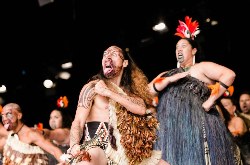Student finds the truth behind ‘truthiness’
9 August 2012
Student finds the truth behind ‘truthiness’
People are more likely to believe something is true if a photograph appears alongside the story, according to findings by a Victoria University student.
Eryn Newman, a PhD student in Victoria’s School of Psychology, has been examining the phenomenon American comedian and news satirist Stephen Colbert calls ‘truthiness’—the feeling that something is true.
In four different experiments Ms Newman, and colleagues at a Canadian university (the University of Victoria, based in British Columbia), discovered that people are more likely to believe claims are true, regardless of whether they actually are true, when a decorative photograph appears alongside the claim. The work is being published this week in a leading psychology journal, the Psychonomic Bulletin & Review.
“We wanted to examine how the kinds of photos people see every day—the ones that decorate newspaper or TV headlines, for example—might produce ‘truthiness’,” says Ms Newman. “We were really surprised by what we found.”
Ms Newman and her colleagues showed people a series of claims such as, “the liquid metal inside a thermometer is magnesium” and asked them to agree or disagree that each claim was true. In some cases, the claim appeared with a decorative photograph that didn’t reveal if the claim was actually true—such as a thermometer. Other claims appeared alone. When a decorative photograph appeared with the claim, people were more likely to agree that the claim was true, regardless of whether it was.
Across all the experiments, the findings fit with the idea that photos might help people conjure up images and ideas about the claim more easily than if the claim appeared by itself. “We know that when it’s easy for people to bring information to mind, it ‘feels’ right,” says Ms Newman.
The research has important implications for situations in which people encounter decorative photos, such as in the media or in education. Professor Maryanne Garry, Deputy Dean of Victoria’s Faculty of Graduate Research, who is based in the School of Psychology, is Ms Newman’s supervisor. She says “decorative photos grab people’s attention. This research suggests that these photos might have unintended consequences, leading people to accept information because of their feelings rather than the facts.”
In 2011, Ms Newman travelled to the University of California, Irvine, on a Fulbright Science and Innovation Graduate Award. While there, she worked with Professor Elizabeth Loftus investigating the ways images can distort eyewitness memory, and how images related to a crime could lead people to misremember details about a crime they had recently witnessed.
Ms Newman’s research is supported by a Marsden Fund grant, and is part of a larger project looking at how images can influence people’s belief and memory.
ENDS


 NZEI Te Riu Roa: Mandated Single Approach To Reading Will Not Work
NZEI Te Riu Roa: Mandated Single Approach To Reading Will Not Work The Conversation: Could The School Phone Ban Work?
The Conversation: Could The School Phone Ban Work? Public Health Communication Centre: To Avoid A Measles Epidemic, Aotearoa Must Close The ‘Immunity Gap’
Public Health Communication Centre: To Avoid A Measles Epidemic, Aotearoa Must Close The ‘Immunity Gap’ Heritage New Zealand: Kid-friendly Archaeology Resource Kit Launched As Part Of Archaeology Week
Heritage New Zealand: Kid-friendly Archaeology Resource Kit Launched As Part Of Archaeology Week Tatai Aho Rau Core Education: Cyber Skills Programme For Tamariki Recognised At Māori Language Awards
Tatai Aho Rau Core Education: Cyber Skills Programme For Tamariki Recognised At Māori Language Awards Waitaha Kapa Haka: Waitaha-South Island Kapa Haka Celebrates 60th Anniversary
Waitaha Kapa Haka: Waitaha-South Island Kapa Haka Celebrates 60th Anniversary